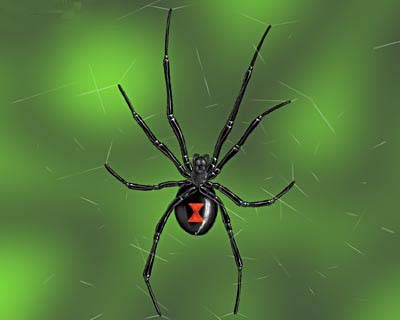Originally shared by Dragos Ruiu
Ya Ta: 128 Byte Raycaster https://finalpatch.blogspot.com/2014/06/dissecting-128-byte-raycaster.html
Originally shared by Dragos Ruiu
Ya Ta: 128 Byte Raycaster https://finalpatch.blogspot.com/2014/06/dissecting-128-byte-raycaster.html
Originally shared by James Williams
Justice Roberts thinks he could have created Ebay.
“At the Supreme Court, every day is Throwback Thursday.”
Originally shared by Jenny Kim
If you’re like me and are always asking people for book recommendations…

Originally shared by John Baez
The black widow’s bite
There are lots of black widows where I live in California. I’ll sometimes see one hanging in its web in a flower pot, sprinkling can or trash bin when I’m gardening. If I think someone might accidentally put their hand there, I’ll kill it.
They are sluggish and unaggressive, so this is easy to do, and I pity them. But their bite — while rarely lethal – is very, very painful. So, I harden my heart and crush them with a broom.
In fact their bite seems fine-tuned to be as bad as possible without being lethal. Maybe this, and the bright red hourglass, is how the spider teaches other animals to stay away! A dead student can’t learn.
Here’s a story passed on by Michael Nielsen, about a med school professor named Allan Blair who decided to get a black widow to bite him. As Wikipedia calmly states, “the test convinced skeptics of the time who thought that the black widow’s venom might not be dangerous to humans.”
This story is from The Red Hourglass by Gordon Grice:
On November 12, Spider 111.33 was, in Blair’s words, “of moderate size, active and glossy black, with characteristic adult markings” — he means the red hourglass — “and appeared to be in excellent condition.” Blair described himself as “aged 32, weighing 168 pounds… athletically inclined and in excellent health.” A former college football player, Blair had just won the university’s faculty tennis championship. He had monitored his body for a week and found his condition “normal.” He had no particular sensitivity to mosquitoes or bees.
At ten forty-five in the morning, Blair used a small forceps to pick Spider 111.33 up by the abdomen and place her on his left hand. Without being prompted, she immediately bit him near the tip of his little finger, “twisting the cephalothorax from side to side as though to sink the claws of the chelicerae deeper into the flesh.” The bite felt like a needle prick and a burn at the same time. Blair let the spider bite him for ten seconds, the burning growing more intense all the while. He removed the widow, putting it back into its jar unharmed.
A drop of “whitish fluid, slightly streaked with brown” beaded at the wound–venom laced with Blair’s blood. The wound itself was so small that Blair couldn’t see it even with a magnifying glass.
Blair’s right hand was busy taking notes. Two minutes after the bite, he recorded a “bluish, pinpoint mark” where he had been bitten; the mark was surrounded by a disk of white skin. The finger was “burning.” Soon the tip of the finger turned red, except for the pale area around the bite. The pain became “throbbing, lancinating.”
Fifteen minutes after the bite, the pain had spread past the base of Blair’s little finger. The side of his hand felt a bit numb. The area around the bite was sweating. The pain quickly traveled up his hand and arm, but it still was worst at the tip of his finger, which had swollen into a purple-red sausage.
At the twenty-two-minute mark, the vanguard of the pain had spread to Blair’s chest, and the worst of it had progressed to his armpit, though the finger continued to throb. Noting the pain in the lymph node near his elbow, Blair deduced that the toxin had traveled through his lymphatic system.
Fifty minutes after the bite, Blair realized that the toxin was traveling in his blood. He felt “dull, drowsy, lethargic”; his blood pressure dropped; his pulse weakened; his breathing seemed deep. His white count began the steep climb it would continue throughout that day and night. His blood pressure and pulse continued to worsen.
Soon he felt flushed and had a headache and a pain in his upper belly. Malaise and pain in the neck muscles developed. Blair turned the note-taking duties over to his assistants. Shortly after noon, he noted that his legs felt “flushed, trembly” and his belly ached and was “tense.” A rigid, pain-racked abdomen is a classic black widow symptom, as Blair knew from his study of other doctors’ cases. He must have suspected he was about to experience pain much, much worse than he already felt. He asked to be taken to the hospital, which was three miles away. The ride took fifteen minutes, during which, as they say in politics, the situation deteriorated.
At half-past noon, Blair was at the hospital. His pulse was “weak and thready.” His belly was rigid and racked with pain. His lower back ached. His chest hurt and felt “constricted.” “Speech was difficult and jerky,” he wrote later, adding in the detached tone obligatory for the medical journal in which he published his results, “respirations were rapid and labored, with a sharp brisk expiration accompanied by an audible grunt.”
Blair’s pains made it difficult for him to lie down for electrocardiograms — in fact, an assistant dutifully wrote down that he described it as “torture” — but he managed to lie still, and the EKGs proved normal. Hearing about the painful EKGs later, newspaper reporters wrongly assumed the venom had injured Blair’s heart. That myth was repeated and embroidered in the press for decades, giving the widow’s danger a spurious explanation easier for casual readers to grasp: heart attack.
Two hours after the bite, Blair lay on his side in fetal position. The pain had reached his legs. His “respirations were labored, with a gasping inspiration and a sharp, jerky expiration accompanied by an uncontrollable, loud, groaning grunt.” He could not straighten his body, which was rigid and trembling; he certainly couldn’t stand. His skin was pale and “ashy” and slick with clammy sweat. In short, he had fallen into deep shock. The bitten finger had turned blue.
Folk remedies reported from places as diverse as Madagascar and southern Europe involved the use of heat, and some doctors had reported hot baths and hot compresses helpful. William Baerg had attested the pain-relieving power of hot baths during his stay in the hospital. Blair decided to try this treatment on himself. As soon as his body was immersed, he felt an almost miraculous reduction of his pain, though it was still severe. His breath laboring, his forearms and hands jerking spastically, he allowed a nurse to take his blood pressure and pulse. His systolic pressure was 75; the diastolic pressure was too faint to determine with a cuff and stethoscope. His pulse remained weak and rapid — too rapid to count.
Forty-five minutes after Blair had arrived at the hospital, his colleague J. M. Forney arrived to take care of him. Forney found Blair lying in the bathtub, gasping for breath, his face contorted into the sweat-slick, heavy-lidded mask that has since come to be recognized as a typical symptom of widow bite. Blair said he felt dizzy. Forney later commented, “I do not recall having seen more abject pain manifested in any other medical or surgical condition.”
After soaking for more than half an hour, Blair was removed from the bath, red as a boiled lobster. His breathing, like his pains, had improved as a result of the bath. Fifteen minutes later, both the ragged breathing and the pain were back at full force. Blair writhed in the hospital bed. Hot water bottles were packed against his back and belly, again reducing his pain. Perspiration poured from him, drenching his sheets. His blood pressure was 80 over 50. His pulse was a weak 120. He accepted an injection of morphine to help with the pain.
Blair continued to gulp down water. Sweat poured out of him and would for days, leaving him little moisture for producing urine. A red streak appeared on his left hand. He vomited and had diarrhea; he couldn’t eat. In the evening of the first day, his blood pressure rebounded to 154 over 92; it stayed high for a week. His face swelled; his eyes were bloodshot and watery.
The night was terrible. He felt restless and could not sleep. The pain persisted. He had chills. A dose of barbiturates didn’t help. He was in and out of hot baths all night. Sometime in that night the worst part came. Blair felt he couldn’t endure any more pain. He said he was about to go insane; he was holding on only by an effort of his steadily weakening will. His caregivers injected him with morphine again.
The next day, his hands trembling, his arm broken out in a knobby rash, his breath stinking, his features distorted by swelling, Blair was still in pain, but he knew he was-getting better. In the evening, as he sat guzzling orange juice, sweat pouring from his body, his worst symptom was pain in the legs.
By the third day, Blair was able to sleep and eat a little. His boardlike abdomen had finally relaxed. He was beginning to look like himself again as his swollen face returned to its normal proportions. He went home that day. It took about a week for all the serious symptoms to vanish. After that, his body itched for two more weeks, and the skin on his hands and feet peeled as if burned.
Here, from Quora, is another story of a black widow bite, written by Brad Porteus. Don’t worry, this one is more comic:
I was holding down the fort with the munchkins (boys 4 and 1¾), and in the interest of creating a morning diversion, we began to make preparations for a walk in the local hills. Sunscreen on, snacks loaded, water filled, stroller out — you know the drill.
I grabbed a pair of old shoes from the garage and hastily threw them on over my bare feet, and I continued my charge around the house to build momentum to get out the door. About a minute later, I realized that there was some wiggling in the toes of my right shoe, and just as I was about to take my shoe off, I felt a prick on the tip of the second toe of my right foot—not painful, but it got my attention.
I took my shoe off on the outside steps and dumped it out, discovering a jet-black inky spider with a body the size of an engorged pea. I instructed my son to grab his bug catcher, which was conveniently nearby, and I dumped the spider into the clear container for inspection.
Imagine my horror when I rotated the container and got a glimpse of a distinct reddish-brown hourglass figure on the belly of the black black spider. OK, I reasoned, I’d lived in those parts for the better part of nearly four decades, and I’d never heard of anyone seeing (let alone getting bit by) a black widow spider, so presumably this is just a copy-cat spider that is harmless.
(He gets a painful bite from a spider with a red hourglass on its belly, and his first guess? It’s a spider imitating a black widow! This gives “optimism” a whole new depth of meaning.)
Well, I suppose before heading out for a walk, I ought to be safe and call the urgent care and see what they think.
After being reassured that there was “no way” I had been bitten by a black widow, the attending physician confessed that she was looking at information on Google (!!!) and started to ask me questions about what it looked like.
After 20 minutes on the phone (with the boys starting to melt down) and getting on the Internet myself, I began to experience my first tell-tale symptom — a slight cramping in my lower right leg.
At this point, the doctor changed position entirely and strongly recommended that I get medical attention immediately.
OK, kids, time to pile into the wagon. We’re heading to the ER.
Ten minutes later, I walked through the doors at the ER at Sequoia Hospital in Redwood City holding the hands of my two boys, along with the bug catcher. “Thirty minutes ago, this spider bit me on this toe, and now this leg is cramping,” I said.
The otherwise bored doctors and nurses—numbed by their predictable flow of blunt trauma, heart palpitations, and other mundane dramas—rapidly appeared out of the woodwork and collectively shouted a big “Yeah!” This, they thought, was so cool.
(Skipping a bit… he gets prescribed opiates to deal with the pain.)
The next 48 hours were literally a blur. I barely remember any of that time and mentally lost track of days and hours. It freaked my wife out when I said I thought my mom had spent the night, so I guess I was hallucinating.
We assumed at the time that the meds were the culprit, but now we’re pretty sure the delirium was a byproduct of the neurotoxins. The medical literature suggests that recovery happens within three to five days. Nights Three, Four, and Five were complete disasters for me. For some completely unknown reason, I was sweating profusely at night. As in literally soaking through my sheets and changing my sheets three times on one night and twice the next. Wet, not damp. Specifically, I was leaking sweat out of my legs. I’d wipe them off, and they’d bead up immediately. It was freaky, to say the least.
Also, I was having trouble concentrating or being coherent for up to five days. Sleep was next to impossible, and I was getting worn down. I later learned my wife was doing her own Google searches to see what the risks were of permanent brain damage. And I think my life insurance was promptly renewed shortly thereafter.
The doctors switched me over from vicodin to valium (one makes the pain go away, one makes you not care about the pain). Finally, I got a decent night sleep on Thursday and a good one on Friday. I awoke on Saturday morning (Day Six) feeling like a human being for the first time and proceeded to clean the garage like a freakin’ maniac.
The moral: if you live in the territory of black widows, keep a clean garage! Don’t let them make nests in your shoes! And don’t stick your hands in flower pots and such things without looking. Yes, you will probably survive if you get bitten. But you will enter realms of experience that you never knew — and don’t want to know!
Here’s what to do if you get bitten:
http://phoenix.about.com/cs/desert/ht/blackwidow.htm

Another view of Varenna at sundown

Varenna, Italy

Lake Como
Originally shared by Yi Yao
Scientist Developed The Guitar Hero of Birds
Bird song hero is a new, visual way to learn bird songs. With the help of spectrogram visualization, you will be able to visualize the unique qualities of each song and commit sound patterns to memory.
The game is quite popular in twitter now, why not give it a try?
http://biology.allaboutbirds.org/bird-song-hero/?_ga=1.255840136.1248268842.1402322118
Originally shared by Lifehacker
Too swole for normal push-ups? This should keep you busy:

Originally shared by Buddhini Samarasinghe
Searching for Sugar Man
If you watch just one documentary this year (or month, or week -depending on how often you watch them), make it this one. In the late 1960s, amidst the height of the apartheid in South Africa, a bootleg recording of an album titled ‘Cold Fact’ by a mysterious American artist known as Rodriguez suddenly became a phenomenon. But his album failed miserably in America, and there were rumours about a gruesome onstage suicide – one in which he set fire to himself. After that, he disappeared into oblivion. But two South African fans turned into musical detectives to find out more about what really happened to him. The story is incredible, with an unbelievable plot-twist. I won’t give it away, but it is a humbling, poignant story that was gripping from start to finish.
And it goes without saying, but the soundtrack is amazing – all original music from Rodriguez.
For those in the UK, you can watch this on BBC iPlayer: http://goo.gl/e313nI
For those outside the UK, this link should work: Sugar Man
Full album ‘Cold Fact’ on YouTube: Sixto Rodriguez- Cold Fact full album